Dharmachakra
The Dharma Chakra (Sanskrit: Dharma Chakra, Pali: dhammacakka, "Wheel of Dharma") is a widespread symbol used in Indian religions such as Hinduism, Jainism and Buddhism.[1][2]
| Part of a series on |
| Buddhism |
|---|
 |
|
|
|
Historically, the dharmachakra was often used as a decoration in Hindu and Buddhist temples, statues and inscriptions, beginning with the earliest period of Indian Buddhism to the present. It remains a major symbol of the Hindu and Buddhist religions today.
Etymology
Sanskrit: "Wheel of the Law." The Sanskrit noun dharma is a derivation from the root dhṛ, which has a meaning of "to hold, maintain, keep",[note 1] and takes a meaning of "what is established or firm" and hence "law". It is derived from the Vedic Sanskrit n-stem dharman- with the meaning "bearer, supporter" in the historical Vedic religion conceived of as an aspect of Ṛta.[4]
History and usage
Similar wheel/chakra symbols are one of the most ancient in all Indian history. Madhavan and Parpola note that a wheel symbol appears frequently in Indus Valley civilization artifacts, particularly on several seals.[5] Notably, it is present in a sequence of ten signs on the Dholavira Signboard.[5] As a solar symbol it first appears on clay seals of the Indus Valley Civilization from 2500 BCE.[6] Such a wheel is also the main attribute of Vishnu.[6]

Some historians associate the ancient chakra symbols with solar symbolism.[7] In the Vedas, the god Surya is associated with the solar disc, which is said to be a chariot of one wheel (cakra). Mitra, a form of Surya, is described as "the eye of the world", and thus the sun is conceived of as an eye (cakṣu) which illuminates and perceives the world.[8] Thus, a wheel symbol might also be associated with light and knowledge.
Buddhist usage and significance
In Buddhism, the Dharma Chakra is widely used to represent the Buddha's Dharma (Buddha's teaching and the universal moral order), Gautama Buddha himself and the walking of the path to enlightenment, since the time of Early Buddhism.[9][1][note 2] The symbol is also sometimes connected to the Four Noble Truths, the Noble Eightfold Path and Dependent Origination. The pre-Buddhist dharmachakra (Pali: dhammacakka) is considered one of the ashtamangala (auspicious signs) in Hinduism and Buddhism and often used as a symbol of both faiths.[10][note 3] It is one of the oldest known Indian symbols found in Indian art, appearing with the first surviving post-Indus Valley Civilization Indian iconography in the time of the Buddhist king Ashoka.[9][9][note 2]
The Buddha is said to have set the "wheel of dharma" in motion when he delivered his first sermon,[11] which is described in the Dhammacakkappavattana Sutta. This "turning of the wheel" signifies a great and revolutionary change with universal consequences, brought about by an exceptional human being. Buddhism adopted the wheel as a symbol from the Indian mythical idea of the ideal king, called a chakravartin ("wheel-turner", or "universal monarch"),[6][11], who was said to possess several mythical objects, including the ratana cakka (the ideal wheel). The Mahā Sudassana Sutta of the Digha Nikaya describes this wheel as having a nave (nābhi), thousand spokes (sahassārāni) and a felly (nemi), all of which are perfect in every respect.[8] Siddhartha Gautama was said to have been a "mahapurisa" (great man) who could have chosen to become a wheel turning king, but instead became the spiritual counterpart to such a king, a wheel turning sage, i.e. a Buddha.[12]
In his explanation of the term "turning the wheel of Dharma", the Theravada exegete Buddhaghosa explains that this "wheel" which the Buddha turned is primarily to be understood as wisdom, knowledge, and insight (ñāṇa). This wisdom has two aspects, paṭivedha-ñāṇa, the wisdom of self-realisation of the Truth and desanā-ñāṇa, the wisdom of proclamation of the Truth.[8] The dharmachakra symbol also points to the central Indian idea of "Dharma", a complex and multivalent term which refers to the eternal cosmic law, universal moral order and in Buddhism, the very teaching and path expounded by the Buddha.[13]
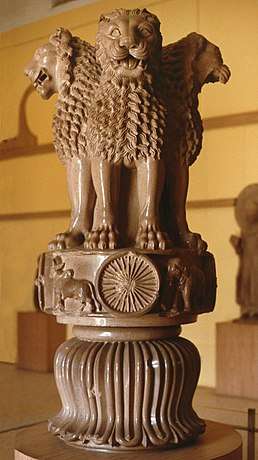
In the Buddhist Art at early sites such as Bharhut and Sanchi, the dharmachakra was often used as a symbol of Gautama Buddha himself.[12][8] The symbol is often paired with the triratna (triple jewel) or trishula (trident) symbolizing the triple gem, umbrellas (chatra), symbols of sovereignty and royal power, gems and garlands. It is also sometimes depicted alongside animals such as lions,[8] or deer.
There are different designs of the Buddhist dharmachakra with 8, 12, 24 or more spokes. In different Buddhist traditions, the different number of spokes may represent different aspects of the Buddha's Dharma (teaching). In the Indo-Tibetan Buddhist tradition for example, the 8 spoked wheel represents the noble eightfold path, and the hub, rim and spokes are also said to represent the three trainings (sila, prajña and samadhi).[14]
In Buddhism, the cyclical movement of a wheel is also used to symbolize the cyclical nature of life in the world (also referred to as the "wheel of samsara", samsara-chakra or the "wheel of becoming", bhava-cakra).[8] This wheel of suffering can be reversed or "turned" through the practice of the Buddhist path. The Buddhist terms for "suffering" (dukkha) and happiness (sukha) may also originally be related to the proper or improper fitting of wheels on a chariot's axle.[15] The Indo-Tibetan tradition has developed elaborate depictions called Bhavacakras which depict the many realms of rebirth in Buddhist cosmology.
The spokes of a wheel are also often used as symbols of the Buddhist doctrine of dependent origination. According to the Theravada scholar Buddhaghosa:
“It is the beginningless round of rebirths that is called the ’Wheel of the round of rebirths’ (saṃsāracakka). Ignorance (avijjā) is its hub (or nave) because it is its root. Ageing-and-death (jarā-maraṇa) is its rim (or felly) because it terminates it. The remaining ten links [of Dependent Origination] are its spokes [i.e. saṅkhāra up to the process of becoming, bhava].”[8]
The earliest Indian monument featuring dharmachakras are the Ashokan Pillars, such as the lion pillar at Sanchi, built at the behest of the Mauryan emperor Ashoka. According to Benjamin Rowland:[8]
”The Sārnāth column may be interpreted, therefore, not only as a glorification of the Buddha’s preaching symbolised by the crowning wheel, but also through the cosmological implications of the whole pillar as a symbol of the universal extension of the power of the Buddha’s Law as typified by the sun that dominates all space and all time, and simultaneously an emblem of the universal extension of Mauryan imperialism through the Dharma. The whole structure is then a translation of age-old Indian and Asiatic cosmology into artistic terms of essentially foreign origin and dedicated, like all Asoka’s monuments, to the glory of Buddhism and the royal house.”
According to Harrison, the symbolism of "the wheel of the law" and the order of Nature is also visible in the Tibetan prayer wheels. The moving wheels symbolize the movement of cosmic order (ṛta).[16]
Jain, Hindu and modern Indian usages
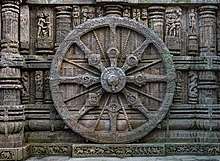

- The dharmachakra is a symbol in the sramana religion of Jainism, sometimes on statues of the Tirthankaras.[17][18][19]
The idea of a great king being associated with turning the "Wheel of Dharma" is something which is shared by Buddhism and Hinduism. In the Vishnu Purana and Bhagavata Purana, two kings named Jadabharata of the Hindu solar and lunar dynasties respectively are referred to as "chakravartins" (wheel turning kings).[20]
Wheel symbolism was widely used in Indian Temples, especially in temples to Surya, the sun god, the most famous of which is the Konark Sun Temple.
In the Bhagavad Gita, verses 14, 15 and 16, of Chapter 3 speaks about the revolving wheel thus:
"From food, the beings are born; from rain, food is produced; rain proceeds from sacrifice (yagnya); yagnya arises out of action; know that from Brahma, action proceeds; Brahma is born of Brahman, the eternal Paramatman. The one who does not follow the wheel thus revolving, leads a sinful, vain life, rejoicing in the senses."[21]
The 24 spoke Ashoka dharmachakra is present in the modern flag of India, representing the pan-Indian and Hindu concept of Dharma.
The modern State Emblem of India is a depiction of the Lion Capital of Ashoka (Sanchi), which includes the dharmachakra. An integral part of the emblem is the motto inscribed in Devanagari script: Satyameva Jayate (English: Truth Alone Triumphs).[22] This is a quote from the Mundaka Upanishad,[23] the concluding part of the Vedas.
Sarvepalli Radhakrishnan, first Vice President of India has stated that the Ashoka Chakra of India represents the "wheel of the law of dharma", as well as "Truth or satya", "Virtue" as well as "motion", as in the "dynamism of a peaceful change".[24]
Other uses and similar symbols
- The main attribute of the Indian god Vishnu is a wheel like weapon called the Sudarśanacakra.[6]
- Similar wheel symbols were used as a solar symbol by the Ancient Egyptians.[25]
- Some Buddha statues also depict the related Dharmachakra Mudrā, a hand sign depicting the turning of the Dharma wheel.
- A very similar wheel symbol also appears in the flag of the Romani people, hinting to their nomadic history and their Indian origins.
- In non-Buddhist cultural contexts, an eight-spoked wheel resembles a traditional ship's wheel. As a nautical emblem, this image is a common sailor tattoo, which may be misidentified as a dharmachakra or vice versa.
- In the Unicode computer standard, the dharmachakra is called the "Wheel of Dharma" and found in the eight-spoked form. It is represented as U+2638 (☸). As emoji: ☸️.
Gallery
Historical and archeological examples
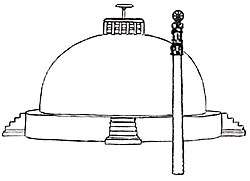 Reconstitution of approximate layout of Sanchi at the time of the Mauryas, showing the pillar topped by a dharmachakra.
Reconstitution of approximate layout of Sanchi at the time of the Mauryas, showing the pillar topped by a dharmachakra.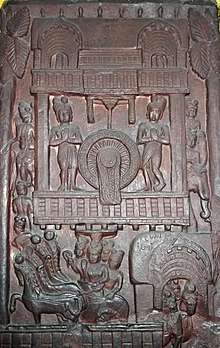 Bharhut Pasenadi Pillar
Bharhut Pasenadi Pillar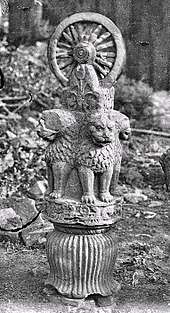 Sanchi pillar capital wheel reconstitution
Sanchi pillar capital wheel reconstitution.jpg) Bharhut Stupa at the Indian Museum, Kolkata
Bharhut Stupa at the Indian Museum, Kolkata- Sandstone depiction, c. 2nd Century BCE, Bharhut, Indian Museum – Kolkata.
 Illustrated reconstruction of the pinnacles at Bharhut by Alexander Cunningham
Illustrated reconstruction of the pinnacles at Bharhut by Alexander Cunningham Eastern gateway of Bharhut stupa topped with a dharmachakra pinnacle
Eastern gateway of Bharhut stupa topped with a dharmachakra pinnacle.jpg) Buddha represented by Dharmacakra, Sanchi Stupa no. 3.
Buddha represented by Dharmacakra, Sanchi Stupa no. 3..jpg) Dharmacakra on Pillar, Sanchi Stupa no. 3
Dharmacakra on Pillar, Sanchi Stupa no. 3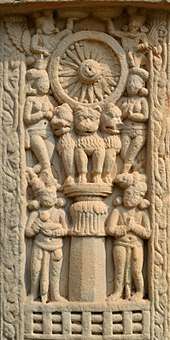 Adoration of the pillar of Ashoka, Sanchi Stupa no. 3.
Adoration of the pillar of Ashoka, Sanchi Stupa no. 3. Illustration from Sanchi Stupa
Illustration from Sanchi Stupa Sanchi Stupa
Sanchi Stupa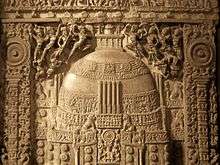 Amaravati Stupa relief at Museum in Chennai, India.
Amaravati Stupa relief at Museum in Chennai, India. Limestone Pilaster, 2nd century CE, Amravati, Indian Museum, Kolkata.
Limestone Pilaster, 2nd century CE, Amravati, Indian Museum, Kolkata. Buddha footprints with dharmachakras, Archaeological Museum, Amaravati
Buddha footprints with dharmachakras, Archaeological Museum, Amaravati 1st century Gandhara Buddha footprint
1st century Gandhara Buddha footprint Gandharan Stele illustrating the first sermon at Sarnath, 2nd century, Metropolitan Museum of Art.
Gandharan Stele illustrating the first sermon at Sarnath, 2nd century, Metropolitan Museum of Art. Stele from Gandhara
Stele from Gandhara A sculpture depicting the dharmachakra in the museum of Amaravathi
A sculpture depicting the dharmachakra in the museum of Amaravathi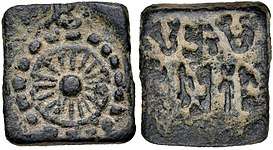 Taxila coin with wheel and Buddhist symbols
Taxila coin with wheel and Buddhist symbols Coin found in Afghanistan, 50 BCE – c. 30 CE, at the latest before 50 CE.
Coin found in Afghanistan, 50 BCE – c. 30 CE, at the latest before 50 CE. Three Jewels, or Triratna. Eastern Afghanistan. Kushan period. 2–3 century.
Three Jewels, or Triratna. Eastern Afghanistan. Kushan period. 2–3 century..jpg) Dhammacakka, National Museum, Bangkok, Thailand
Dhammacakka, National Museum, Bangkok, Thailand.jpg) Dhammacakka, National Museum, Bangkok, Thailand
Dhammacakka, National Museum, Bangkok, Thailand Khao Klang Nai, Si Thep Historical Park, Thailand.
Khao Klang Nai, Si Thep Historical Park, Thailand. Mon dharmachakra, VII or IX century, Sandstone
Mon dharmachakra, VII or IX century, Sandstone Dharma wheel, Japan, Kamakura period, 1200s CE, bronze – Tokyo National Museum.
Dharma wheel, Japan, Kamakura period, 1200s CE, bronze – Tokyo National Museum. Part of a Buddha-statue, showing the first five disciples of the Buddha at Sarnath and dharmachakra.
Part of a Buddha-statue, showing the first five disciples of the Buddha at Sarnath and dharmachakra._MET_DT352194.jpg) Japanese dharmachakra, late 13th century.
Japanese dharmachakra, late 13th century. Mandala Base, China, Ming dynasty, Cleveland Museum of Art.
Mandala Base, China, Ming dynasty, Cleveland Museum of Art. Dharma wheel, China, Qing dynasty, Qianlong period, 1736–1795 CE.
Dharma wheel, China, Qing dynasty, Qianlong period, 1736–1795 CE.- Box with Ink Cakes: Yellow Ink Stick, China, Qing dynasty (1644–1912).
Contemporary examples
 Jokhang Monastery
Jokhang Monastery.jpg) Wat Phothivihan, Tumpat, Kelantan
Wat Phothivihan, Tumpat, Kelantan.jpg) Wat Maisuwankiri, Tumpat, Malaysia
Wat Maisuwankiri, Tumpat, Malaysia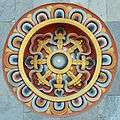 Bhutanese Dharmachakra, Thimphu
Bhutanese Dharmachakra, Thimphu.jpg) Entrance to Wat Phra Sing
Entrance to Wat Phra Sing.jpg) Yakkha upholding the Dhammacakka, Wat Sri Suphan, Chiang Mai
Yakkha upholding the Dhammacakka, Wat Sri Suphan, Chiang Mai Dharmachakra at Boudanath
Dharmachakra at Boudanath.jpg) Dhammacakka on Main Gable, Wat Phra Putthabat Tak Pha, Lamphun
Dhammacakka on Main Gable, Wat Phra Putthabat Tak Pha, Lamphun Entrance to the Global Vipassana Pagoda
Entrance to the Global Vipassana Pagoda
National flags and official symbolism
 The Emblem of Mongolia includes the dharmachakra, a cintamani, a padma, blue khata and the Soyombo symbol
The Emblem of Mongolia includes the dharmachakra, a cintamani, a padma, blue khata and the Soyombo symbol The Emblem of Sri Lanka, featuring a blue dharmachakra as the crest
The Emblem of Sri Lanka, featuring a blue dharmachakra as the crest The Emblem of India, featuring the Ashoka Chakra on the base panel representing the Dharmachakra
The Emblem of India, featuring the Ashoka Chakra on the base panel representing the Dharmachakra
.svg.png) The flag of the former Kingdom of Sikkim featured a version of the Dharmachakra
The flag of the former Kingdom of Sikkim featured a version of the Dharmachakra Emblem of Central Tibetan Administration with Tibetan Buddhist style Dharmachakra
Emblem of Central Tibetan Administration with Tibetan Buddhist style Dharmachakra.svg.png) The dhammacakka flag, the symbol of Buddhism in Thailand
The dhammacakka flag, the symbol of Buddhism in Thailand The seal of Thammasat University in Thailand consisting of a Constitution on phan with a twelve-spoked dhammacakkka
The seal of Thammasat University in Thailand consisting of a Constitution on phan with a twelve-spoked dhammacakkka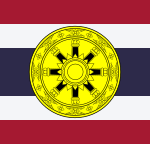 Colours of the National Scout Organization of Thailand
Colours of the National Scout Organization of Thailand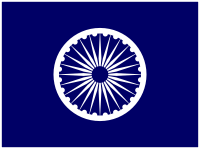 Flag used by the Indian Dalit Buddhist Movement
Flag used by the Indian Dalit Buddhist Movement The insignia for Buddhist chaplains in the United States Armed Forces.
The insignia for Buddhist chaplains in the United States Armed Forces. Wheel in Jain Symbol of Ahimsa represents dharmachakra
Wheel in Jain Symbol of Ahimsa represents dharmachakra USVA headstone emblem 2
USVA headstone emblem 2
Notes
- Monier Williams, A Sanskrit Dictionary (1899): "to hold, bear (also: bring forth), carry, maintain, preserve, keep, possess, have, use, employ, practise, undergo"[3]
- Grünwedel e.a.:"The wheel (dharmachakra) as already mentioned, was adopted by Buddha's disciples as the symbol of his doctrine, and combined with other symbols—a trident placed above it, etc.—stands for him on the sculptures of the Asoka period."[9]
- Goetz: "dharmachakra, symbol of the Buddhist faith".[10]
References
- John C. Huntington, Dina Bangdel, The Circle of Bliss: Buddhist Meditational Art, p. 524.
- "Buddhist Symbols". Ancient-symbols.com. Retrieved 22 June 2018.
- Monier Willams
- Day 1982, p. 42–45.
- The Ancient Indus Valley: New Perspectives By Jane McIntosh. p. 377
- Beer 2003, p. 14.
- Issitt, Micah. Main, Carlyn. (2014). Hidden Religion: The Greatest Mysteries and Symbols of the World's Religious Beliefs, ABC-CLIO, p. 185.
- T. B. Karunaratne (1969), The Buddhist Wheel Symbol, The Wheel Publication No. 137/138, Buddhist Publication Society, Kandy • Sri Lanka.
- Grünwedel 1901, p. 67.
- Goetz 1964, p. 52.
- Pal 1986, p. 42.
- Ludowyk, E.F.C. (2013) The Footprint of the Buddha, Routledge, p. 22.
- Issitt, Micah. Main, Carlyn. (2014). Hidden Religion: The Greatest Mysteries and Symbols of the World's Religious Beliefs, ABC-CLIO, p. 186.
- A Lamp Illuminating the Path to Liberation: An Explanation of Essential Topics for Dharma Students by Khenpo Gyaltsen (translated by Lhasey Lotsawa Translations, Nepal: 2014, pp. 247–248).
- Sargeant, Winthrop (2009), The Bhagavad Gita, SUNY Press, p. 303.
- Harrison & 2010 (1912), p. 526.
- Framing the Jina: Narratives of Icons and Idols in Jain History, p. 314, by John Cort, Oxford University
- Asha Kalia, Art of Osian Temples: Socio-economic and Religious Life in India, 8th–12th Centuries A.D. Abhinav Publications, 1982, chapter 16.
- Sharma, Savita (1990). Early Indian Symbols: Numismatic Evidence, Agam Kala Prakashan, 1990 p. 51.
- Titze, Kurt; Bruhn, Klaus (22 June 1998). "Jainism: A Pictorial Guide to the Religion of Non-violence". Motilal Banarsidass. Retrieved 22 June 2018 – via Google Books.
- "The Bhagavad-gita" (PDF). Vivekananda.net. Retrieved 22 June 2018.
- Kamal Dey v. Union of India and State of West Bengal (Calcutta High Court 2011-07-14). Text
- "Rajya Sabha Parliamentary Standing Committee On Home Affairs: 116th Report on The State Emblem Of India (Prohibition Of Improper Use) Bill, 2004" (PDF). Archived from the original (PDF) on 8 March 2013.
- "The national flag code" (PDF). Mahapolice.gov.in. Archived from the original (PDF) on 15 December 2017. Retrieved 22 June 2018.
- Hall, Adelaide S. (2005). A Glossary of Important Symbols in Their Hebrew: Pagan and Christian Forms. p. 56. ISBN 978-1-59605-593-3.
Sources
- Anthony, David W. (2007), The Horse The Wheel and Language. How Bronze-Age Riders From The Eurasian Steppes Shaped The Modern World, Princeton University Press
- Beer, Robert (2003), The Handbook of Tibetan Buddhist Symbols, Serindia Publications, Inc., ISBN 978-1932476033
- Day, Terence P. (1982), The Conception of Punishment in Early Indian Literature, Ontario: Wilfrid Laurier University Press, ISBN 0-919812-15-5
- Goetz, Hermann (1964), The art of India: five thousand years of Indian art, Crown
- Grünwedel, Albert; Gibson, Agnes C.; Burgess, James (1901), Buddhist art in India, Bernard Quaritch
- Harrison, Jane Ellen (2010) [1912], Themis: A Study of the Social Origins of Greek Religion, Cambridge University Press
- Hiltebeitel, Alf (2007), Hinduism. In: Joseph Kitagawa, "The Religious Traditions of Asia: Religion, History, and Culture". Digital printing 2007, Routledge
- Inden, Ronald (1998), Ritual, Authority, And Cycle Time in Hindu Kingship. In: JF Richards, ed., "Kingship and Authority in South Asia", New Delhi: Oxford University Press
- Mallory, J.P. (1997), Encyclopedia of Indo-European Culture, London: Fitzroy Dearborn Publishers, ISBN 978-1-884964-98-5
- Nath, Vijay (March–April 2001), "From 'Brahmanism' to 'Hinduism': Negotiating the Myth of the Great Tradition", Social Scientist: 19–50, doi:10.2307/3518337, JSTOR 3518337
- Pal, Pratapaditya (1986), Indian Sculpture: Circa 500 B.C.–A.D. 700, University of California Press
- Queen, Christopher S.; King, Sallie B. (1996), Engaged Buddhism: Buddhist liberation movements in Asia., SUNY Press
- Samuel, Geoffrey (2010), The Origins of Yoga and Tantra. Indic Religions to the Thirteenth Century, Cambridge University Press
- Yan, Xiaojing (2009), The confluence of East and West in Nestorian Arts in China. In: Dietmar W. Winkler, Li Tang (eds.), Hidden Treasures and Intercultural Encounters: Studies on East Syriac Christianity in China and Central Asia, LIT Verlag Münster
Further reading
- Dorothy C. Donath (1971). Buddhism for the West: Theravāda, Mahāyāna and Vajrayāna; a comprehensive review of Buddhist history, philosophy, and teachings from the time of the Buddha to the present day. Julian Press. ISBN 0-07-017533-0.
External links

| Wikiquote has quotations related to: Dharmachakra |
